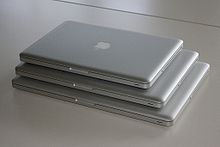February 12, 2011
The Mac OS X operating system has been pre-installed on all MacBooks Pros since release, starting with version 10.4.4 (Tiger).[1] Along with OS X, iLife has also shipped with all systems, beginning with iLife '06.[1] The MacBook Pro comes with the BIOS successor, Extensible Firmware Interface (EFI) 1.1. EFI handles booting differently from conventional BIOS-based computers,[59] but provides BIOS backwards compatibility, allowing dual and triple boot configurations. In addition to Mac OS X, the Microsoft Windows operating system is installable on Intel x86-based Apple computers. Officially, this is limited to both 32-bit and 64-bit versions of Windows XP, Vista, and 7, with the necessary hardware drivers included with the Boot Camp software.[55][60] Other x86 operating systems such as Linux are also unofficially supported.[61] This is made possible by the presence of the Intel architecture as provided by the CPU and the BIOS emulation Apple has provided on top of EFI.[62][63] [edit]Compatibility- PowerPC emulation: As the MacBook Pro uses a different hardware platform than earlier PowerPC (PPC)-based Macintoshes, it is incapable of running PPC applications natively. It instead uses the Rosetta emulator to seamlessly run PPC applications, though at some performance penalty. Due to the manner in which Apple chose to implement it, Rosetta is incapable of emulating some lower level PPC code, and does not support 64-bit (G5 specific) PPC features.[64]
- Classic emulation: Intel-based Macs do not support Mac OS X's Classic emulation environment (Mac OS 9 and earlier), although third-party emulators such as SheepShaver may allow these applications to run.[65][66]
Posted by Shaheer Ahmed.
February 12, 2011
DesignThe unibody-construction MacBook Pro largely follows the styling of the original aluminum iMac and the MacBook Air and is slightly thinner than its predecessor, albeit wider and deeper due to thewidescreen display.[27] The screen is high-gloss, covered by an edge-to-edge reflective glass finish, while an anti-glare matte option is available in the 15- and 17-inch models in which the glass panel is removed.[37] The trackpad has also been enlarged, giving more room for scrolling and multi... Continue reading...
Posted by Shaheer Ahmed.
February 12, 2011
Unibody MacBook Pro A size comparison of the unibody line of MacBook Pro laptops. On October 14, 2008, at a notebook-oriented event at Apple's headquarters, a new 15-inch MacBook Pro was announced featuring an aluminum unibody construction and tapered sides similar to those of the MacBook Air.[27] This method of construction has been dubbed "precision aluminum unibody enclosure" by Apple, usually shortened to "unibody".[28] All of the MacBook Pro's ports were shifted to the left side of the cas... Continue reading...
Posted by Shaheer Ahmed.
February 12, 2011
Upon release, reviewers noted the speed increase of the MacBook Pro when compared to the PowerBook G4 as well as the improved wireless performance.[3]Reviewers were impressed with the performance increase offered by the 15-inch MacBook Pro over the PowerBook G4. At times, two- or threefold improvements in performance were seen;[3] for example, the 3D rendering program Cinema 4D XL was 3.3 times faster[3] and the boot-up time was more than halved.[4] The MacBook Pro generally performs better o... Continue reading...
Posted by Shaheer Ahmed.
February 12, 2011
The original 15-inch MacBook Pro was announced on January 10, 2006 by Steve Jobs at the Macworld Conference & Expo.[1] The 17-inch model was later unveiled on April 24, 2006.[2] The first design was largely a carryover from the PowerBook G4 and utilized Intel Core CPUs as opposed to the PowerPC G4chips used by its predecessor[3]. It is 0.1 inches (0.25 cm) deeper, 0.4 inches (1.0 cm) wider, and 0.1 inches (0.25 cm) thinner than the 15-i... Continue reading...
Posted by Shaheer Ahmed.
February 11, 2011
The MacBook Pro is a line of Macintosh portable computers introduced in January 2006 by Apple Inc. It replaced the PowerBook G4 and was the second model to be announced in the Apple–Intel transition (after the iMac). Positioned at the high end of the MacBook family, the MacBook Pro is currently produced in three sizes: the 13-, 15-, and 17- inch. There have been two designs for the MacBook Pro, both using aluminum. The first design was largely a carry-over from the PowerBook G4 and used the ... Continue reading...
Posted by Shaheer Ahmed.
|
|

